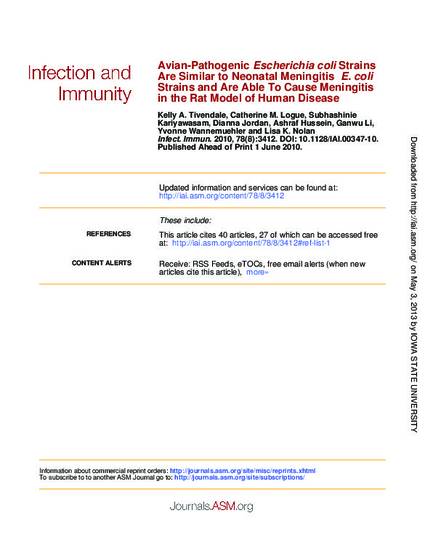
Article
Avian-Pathogenic Escherichia coli Strains Are Similar to Neonatal Meningitis E. coli Strains and Are Able To Cause Meningitis in the Rat Model of Human Disease
Infection and Immunity
Document Type
Article
Disciplines
Publication Date
8-1-2010
DOI
10.1128/IAI.00347-10
Abstract
Escherichia coli strains causing avian colibacillosis and human neonatal meningitis, urinary tract infections, and septicemia are collectively known as extraintestinal pathogenic E. coli (ExPEC). Characterization of ExPEC strains using various typing techniques has shown that they harbor many similarities, despite their isolation from different host species, leading to the hypothesis that ExPEC may have zoonotic potential. The present study examined a subset of ExPEC strains: neonatal meningitis E. coli (NMEC) strains and avian-pathogenic E. coli(APEC) strains belonging to the O18 serogroup. The study found that they were not easily differentiated on the basis of multilocus sequence typing, phylogenetic typing, or carriage of large virulence plasmids. Among the APEC strains examined, one strain was found to be an outlier, based on the results of these typing methods, and demonstrated reduced virulence in murine and avian pathogenicity models. Some of the APEC strains tested in a rat model of human neonatal meningitis were able to cause meningitis, demonstrating APEC's ability to cause disease in mammals, lending support to the hypothesis that APEC strains have zoonotic potential. In addition, some NMEC strains were able to cause avian colisepticemia, providing further support for this hypothesis. However, not all of the NMEC and APEC strains tested were able to cause disease in avian and murine hosts, despite the apparent similarities in their known virulence attributes. Thus, it appears that a subset of NMEC and APEC strains harbors zoonotic potential, while other strains do not, suggesting that unknown mechanisms underlie host specificity in some ExPEC strains.
Copyright Owner
American Society for Microbiology
Copyright Date
2010
Language
en
File Format
application/pdf
Citation Information
Kelly A. Tivendale, Catherine M. Logue, Subhashinie Kariyawasam, Dianna Jordan, et al.. "Avian-Pathogenic Escherichia coli Strains Are Similar to Neonatal Meningitis E. coli Strains and Are Able To Cause Meningitis in the Rat Model of Human Disease" Infection and Immunity Vol. 78 Iss. 8 (2010) p. 3412 - 3419 Available at: http://works.bepress.com/lisa_nolan/11/

This article is from Infection and Immunity 78, no. 8 (August 2010): 3412–3419, doi:10.1128/IAI.00347-10.